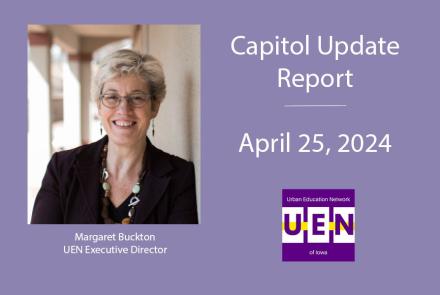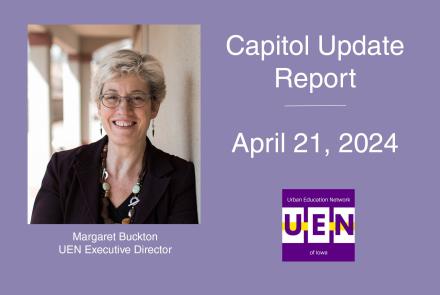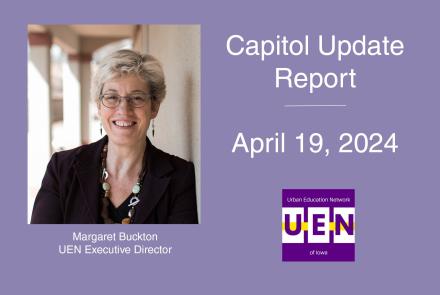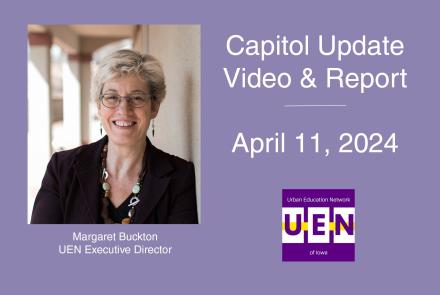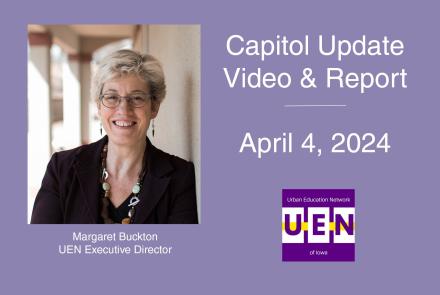UEN Call to Action – Administrative Expenditure Limitation SF 251
CALL TO ACTION
Administrative Expenditure Limitation SF 251
March 8, 2024
Download the printable Call to Action on Administrative Expenditure Limitation
SF 251 was approved by the Senate during the 2023 Legislative Session, 36:12, but died in the House Education Committee last year. A subcommittee of Reps. Gehlbach, Buck and Johnson was assigned this week, which may indicate the House Education Committee’s willingness to move the bill forward. To survive, the bill would have to be approved by the House Education Committee by the next funnel deadline, March 15. They have a meeting scheduled for Thursday, March 14. UEN is registered opposed (as are most other public education entities, with only the Iowans for Tax Relief registering in support). The definition of administrative expenditures in the bill is very problematic.
Reach out to House Education Committee Members at home over the weekend and at the Capitol early next week. To call and leave a message at the Statehouse, the House switchboard operator number is 515.281-3221. You can ask if they are available, leave a message for them to call you back, or just leave a short message such as “Please oppose the Senate’s SF 251 Limitation on School Administration Expenses.” (Legislators are typically at the Capitol from Monday midday through Thursday afternoon.)
What the bill does: 1) eliminates the current 5% limitation on “executive administration,” which is considered the expenses for the school board and superintendent’s office for all districts. 2) Creates a new definition of “administrative expenditures” to mean activities that do not directly relate to student instruction or to the activity of students, and limits those expenditures to no more than 5% of the school’s general fund for districts with budget enrollment greater than 1,000. The July 1, 2024 effective date last year was intended to allow the State Board of Education to engage in the rulemaking process before school districts were impacted. We would expect that date to change to July 1, 2025 if the bill is to move forward. Here’s the bill in its entirety:
Section 1. Section 279.45, Code 2023, is amended to read as follows:
279.45 Administrative expenditures.
The For school districts with a budget enrollment of one thousand or more, the administrative expenditures as a percent of a the school district’s general fund for a base year shall not exceed five percent. Annually, the board of directors of each school district in the state shall certify to the department of education the amounts of the school district’s administrative expenditures and its general fund. For the purposes of this section, “base year” means the same as defined in section 257.2, and “administrative expenditures” means expenditures for executive administration school district purposes or activities that do not directly relate to student instruction or to the activity of students, but instead support the program delivery and development activities including but not limited to salaries for administrators and office staff, school administration, general administration, and data processing and collection services. The state board shall adopt rules pursuant to chapter 17A for the interpretation and proper administration of this section.
Sec. 2. APPLICABILITY. This Act applies July 1, 2024, for school budget years beginning on or after that date.
Background: Senator Zaun, Sponsor and Floor Manager of the bill in the Senate last year, referenced a spreadsheet that showed the change in students, teacher FTEs, all other FTEs and total FTEs, from FY 1993 to FY 2021. He stated his belief that administrators are paid too much and districts should be spending more money on classrooms. The footnotes on this spreadsheet indicate the data was from NCES:
|
|
Share of Districts |
|
Staffing Surge* |
95% |
|
Teacher Surge** |
88% |
|
Non-Teacher Surge*** |
95% |
|
This information comes from data sent by your state to the National Center for Education Statistics (NCES) at the U.S. Department of Education. |
|
|
The data was retrieved from NCES at https://nces.ed.gov/ccd/elsi/ |
|
|
Please report any errors in the data to your state department of education so they may make the correction with the NCES at the U.S. Department of Education. |
|
|
* Percent of districts where the growth in total staff was greater than the growth in students |
|
|
** Percent of districts where the growth in teachers was greater than the growth in students |
|
|
*** Percent of districts where the growth in non-teaching staff was greater than the growth in students |
|
Verify your local numbers found in the district analysis here: District Staffing Surge 1993 to 2021
Several policy explanations explain the “staffing surge” defined as growth in teachers and non-teacher’s outpacing growth in students since 1993.
1) transition from half day to full day kindergarten by most districts and initiation of the statewide voluntary preschool program which limits class sizes.
2) teacher leadership and compensation (TLC) plan requiring 25% of teachers to have a leadership role, in most cases, without full time classroom responsibilities
3) full inclusion of special education students in regular education classrooms
4) doubling of student poverty in Iowa with increased Title I funding and commensurate increase in administrative burden and programs directed at this population
5) significant increase in the number and percentage of students requiring English-language learner support
6) a series of unfunded mandates requiring administrative work; for examples, bullying and harassment investigations, Title I coordinator, TAG coordinator, administration of mandated FAST screeners and assessments, development of professional development plans, school safety plans, technology plans, behavior plans for an increasingly larger number of students, training staff, improving instruction, using technology effectively, staff for cyber security and data systems, and the explosion of reporting requirements to the state, responding to teacher calls for assistance with student behavior issues, and implementing policies required by the state, just to name a few.
The National Conference of Education Statistics, NCES, defines administrative costs as: “Administration (District Expenditure): Expenditures for the administration of schools and school districts. Includes expenditures for: the board of education, administration of Local Education Agencies, the office of the principal, full-time department chairpersons, graduation expenses, and business and central offices (fiscal services, budgeting, payroll, purchasing, storage, material distribution, planning, research, evaluation, staff recruitment and data processing).”
This definition is likely less expansive than that which is proposed in SF 251, yet would still place all 327 school districts out of compliance.
Key Messages: Ask Representatives to oppose SF 251 Administrative Expenditure Limitation.
- The definition of administration in SF 251 is very broad and leaves the DE little discretion to align with accounting codes already required to be reported.
- Costs for data management and cyber security have exploded in recent years. Technology data systems are required by the state and demand competent staffing. Some software licenses are paid from PPEL or State Penny Sales Tax, not out of the general fund, which complicates the reporting requirements of this bill.
- Every district would be out of compliance if the limitation is set at 5% and would have to cut expenditures and lay off staff to comply.
- Forced reduction of administrative and support staff would increase the workload of teachers.
- Many administrators are providing instructional functions, from teaching classes to providing professional development to improve instruction. Would this bill require all administrators to keep time sheets and code some of their hours differently?
- Much of the growth in non-teaching positions since 1993 is due to mandates and requirements of state and federal government, changes in student needs and increased requirements for the use of data systems. If your representatives ask questions about the “staffing surge”, see your district-specific data on the FTE growth spreadsheet shared by Sen. Zaun (Bill Sponsor and Floor Manager in the Senate in 2023) District Staffing Surge 1993 to 2021. Confirm the changes in your district and explain why those numbers have grown faster than the FTE teacher count or enrollment.
- See NCES data per district with their definition of administrative expenditures (Executive plus school administration but does not include data processing or other requirements that might be added during the rulemaking process) posted here NCES Data 2019 by Admin Expenditures Percentage.
Find your Representatives here: https://www.legis.iowa.gov/legislators/house
Reach out to House Education Committee Members at home over the weekend and at the Capitol early next week. To call and leave a message at the Statehouse, the House switchboard operator number is 515.281-3221. You can ask if they are available, leave a message for them to call you back, or just leave a short message such as “Please oppose the Senate’s SF 251 Limitation on School Administration Expenses.” (Legislators are typically at the Capitol from Monday midday through Thursday afternoon.)



